NGC 4631 is a barred spiral galaxy in the constellation Canes Venatici about 30 million light years away from Earth. This galaxy's slightly distorted wedge shape gives it the appearance of a herring or a whale, hence its nickname. Because this nearby galaxy is seen edge-on from Earth, professional astronomers observe this galaxy to better understand the gas and stars located outside the plane of the galaxy.
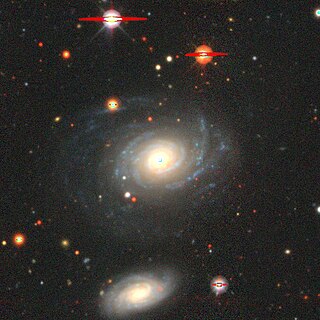
NGC 1 is an intermediate spiral galaxy of the morphological type Sbc, located in the constellation of Pegasus. It was discovered on 30 September 1861 by Heinrich d'Arrest.

The Antlia Cluster is a cluster of galaxies located in the Hydra–Centaurus Supercluster. The Antlia Cluster is the third-nearest to the Local Group after the Virgo Cluster and Fornax Cluster. Antlia's distance from Earth is 40.5 megaparsecs to 40.9 Mpc (133.4 Mly) and can be viewed from Earth in the constellation Antlia. The Antlia Cluster should not be confused with the Antlia Dwarf galaxy.

NGC 210 is a barred spiral galaxy located roughly 67 million light-years from the Solar System in the constellation Cetus. It was discovered on October 3, 1785 by William Herschel and later added to the New General Catalogue.

NGC 67 is an elliptical galaxy located in the constellation Andromeda that was discovered on October 7, 1855, by R. J. Mitchell, who described it as "extremely faint, very small, round". The galaxy belongs to the NGC 68 group, which also contains the galaxies NGC 68, NGC 69, NGC 70, NGC 71, NGC 72, and possibly NGC 74.

NGC 68 is a lenticular galaxy, and the central member of the NGC 68 group, in the constellation Andromeda. The galaxy was discovered on September 11, 1784, by William Herschel, who observed the NGC 68 group as a single object and described it as "extremely faint, large, 3 or 4 stars plus nebulosity". As such, his reported location is between NGC 68, NGC 70, and NGC 71. By the time Dreyer looked at the galaxies to add to the NGC catalog, however, he was able to tell that the single galaxy observed by Herschel was in fact 3 adjacent galaxies, and cataloged them as NGC 68, NGC 70, and NGC 71.

NGC 428 is a barred spiral galaxy in the constellation of Cetus, with its spiral structure distorted and warped, possibly the result of the collision of two galaxies. There appears to be a substantial amount of star formation occurring within NGC 428 and it lacks well defined arms — a telltale sign of a galaxy merger. In 2015 the Hubble Space Telescope made a close-up shot of the galaxy with its Advanced Camera for Surveys and its Wide Field and Planetary Camera 2. The structure of NGC 428 has been compared to NGC 5645.

NGC 375 is an elliptical galaxy located in the constellation Pisces. It was discovered on September 12, 1784 by William Herschel. It was described by Dreyer as "pretty faint, small, round, brighter middle." Along with galaxies NGC 379, NGC 380, NGC 382, NGC 383, NGC 384, NGC 385, NGC 386, NGC 387 and NGC 388, NGC 375 forms a galaxy cluster called Arp 331.
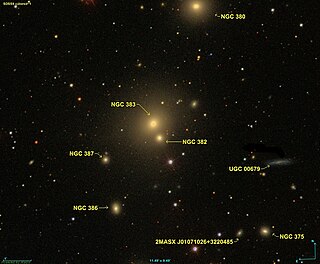
NGC 382 is an elliptical galaxy located in the constellation Pisces. Its discovery has been credited to William Parsons.

NGC 380 is an elliptical galaxy located in the constellation Pisces. It was discovered on September 12, 1784 by William Herschel. It was described by Dreyer as "pretty faint, small, round, suddenly brighter middle." Along with galaxies NGC 375, NGC 379, NGC 382, NGC 383, NGC 384, NGC 385, NGC 386, NGC 387 and NGC 388, NGC 380 forms a galaxy cluster called Arp 331.

NGC 384 is an elliptical galaxy located in the constellation Pisces. It was discovered on November 4, 1850, by Bindon Stoney. It was described by Dreyer as "pretty faint, pretty small, southwestern of 2.", the other being NGC 385. Along with galaxies NGC 375, NGC 379, NGC 382, NGC 383, NGC 385, NGC 386, NGC 387 and NGC 388, NGC 384 forms a galaxy cluster called Arp 331.
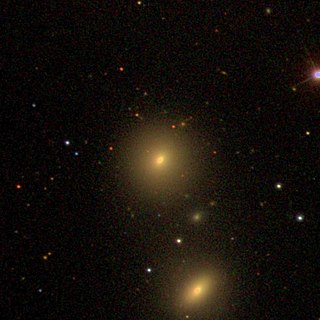
NGC 385 is an unbarred lenticular galaxy located in the constellation Pisces. It was discovered on November 4, 1850, by Bindon Stoney. It was described by Dreyer as "pretty faint, pretty small, round, northeastern of 2.", the other being NGC 384. Along with galaxies NGC 375, NGC 379, NGC 382, NGC 383, NGC 384, NGC 386, NGC 387 and NGC 388, NGC 385 forms a galaxy cluster called Arp 331.
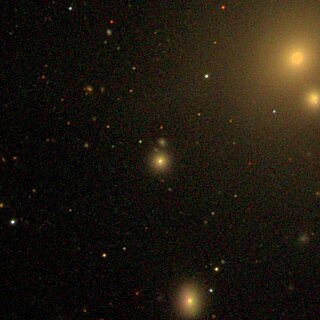
NGC 387 is an elliptical galaxy located in the constellation Pisces. It was discovered on December 10, 1873 by Lawrence Parsons. It was described by Dreyer as "very faint, small, round." Along with galaxies NGC 375, NGC 379, NGC 382, NGC 383, NGC 384, NGC 385, NGC 386 and NGC 388, NGC 387 forms a galaxy cluster called Arp 331.

NGC 388 is an elliptical galaxy located in the constellation Pisces. It was discovered on November 4, 1850, by Bindon Stoney. It was described by Dreyer as "very faint, small, round." Along with galaxies NGC 375, NGC 379, NGC 382, NGC 383, NGC 384, NGC 385, NGC 386 and NGC 387, NGC 388 forms a galaxy cluster called Arp 331.

NGC 4596 is a barred lenticular galaxy located about 55 million light-years away in the constellation Virgo. NGC 4596 was discovered by astronomer William Herschel on March 15, 1784. NGC 4596 is a member of the Virgo Cluster and has an inclination of about 38°.
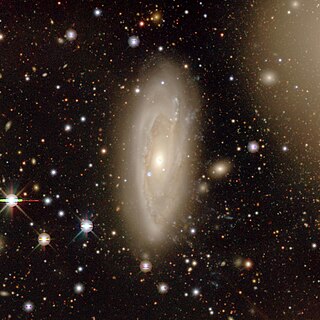
NGC 3312 is a large and highly inclined spiral galaxy located about 194 million light-years away in the constellation Hydra. The galaxy was discovered by astronomer John Herschel on March 26, 1835. It was later rediscovered by astronomer Guillaume Bigourdan on February 26, 1887. NGC 3312 was later listed and equated with IC 629 because the two objects share essentially the same celestial coordinates. NGC 3312 is the largest spiral galaxy in the Hydra Cluster and is also classified as a LINER galaxy.

NGC 6907 is a spiral galaxy located in the constellation Capricornus. It is located at a distance of about 120 million light-years from Earth, which, given its apparent dimensions, means that NGC 6907 is about 115,000 light-years across. It was discovered by William Herschel on July 12, 1784. The total infrared luminosity of the galaxy is 1011.03 L☉, and thus it is categorised as a luminous infrared galaxy.

NGC 5846 is an elliptical galaxy located in the constellation Virgo. It is located at a distance of circa 90 million light years from Earth, which, given its apparent dimensions, means that NGC 5846 is about 110,000 light years across. It was discovered by William Herschel on February 24, 1786. It lies near 110 Virginis and is part of the Herschel 400 Catalogue. It is a member of the NGC 5846 Group of galaxies, itself one of the Virgo III Groups strung out to the east of the Virgo Supercluster of galaxies.
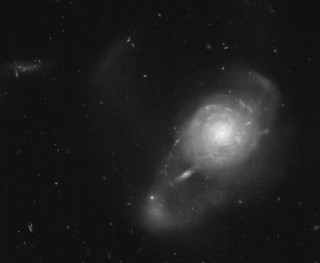
NGC 7679 is a lenticular galaxy with a peculiar morphology in the constellation Pisces. It is located at a distance of circa 200 million light years from Earth, which, given its apparent dimensions, means that NGC 7679 is about 60,000 light years across. It was discovered by Heinrich d'Arrest on September 23, 1864. The total infrared luminosity is 1011.05 L☉, and thus it is categorised as a luminous infrared galaxy. NGC 7679 is both a starburst galaxy and a Seyfert galaxy.

NGC 4324 is a lenticular galaxy located about 85 million light-years away in the constellation Virgo. It was discovered by astronomer Heinrich d'Arrest on March 4, 1862. NGC 4324 has a stellar mass of 5.62 × 1010M☉, and a baryonic mass of 5.88 × 1010M☉. The galaxy's total mass is around 5.25 × 1011M☉. NGC 4324 is notable for having a ring of star formation surrounding its nucleus. It was considered a member of the Virgo II Groups until 1999, when its distance was recalculated and it was placed in the Virgo W Group.


















